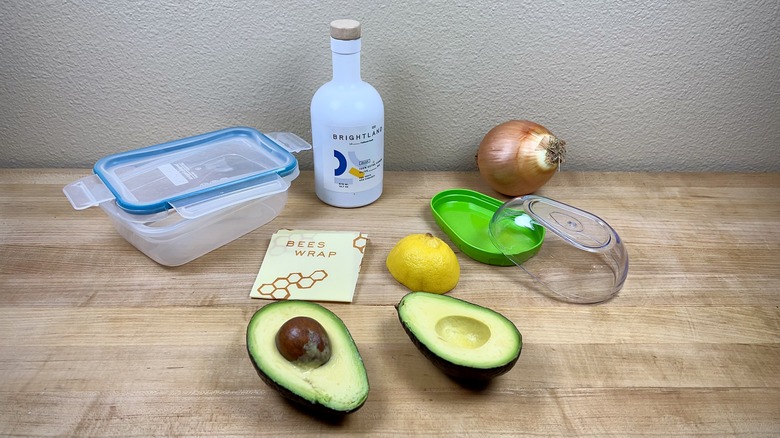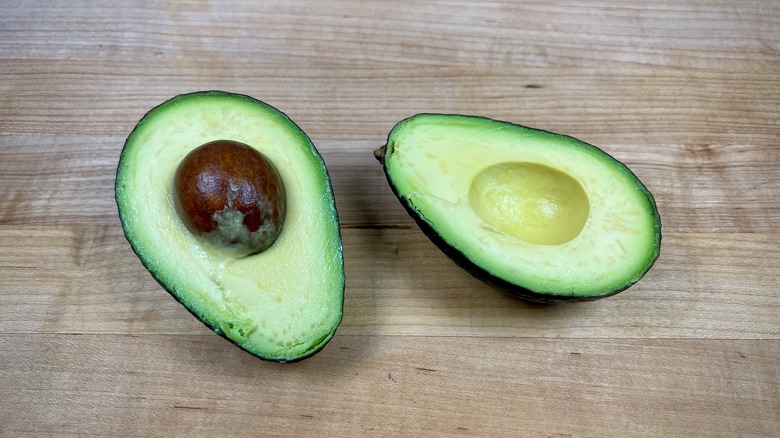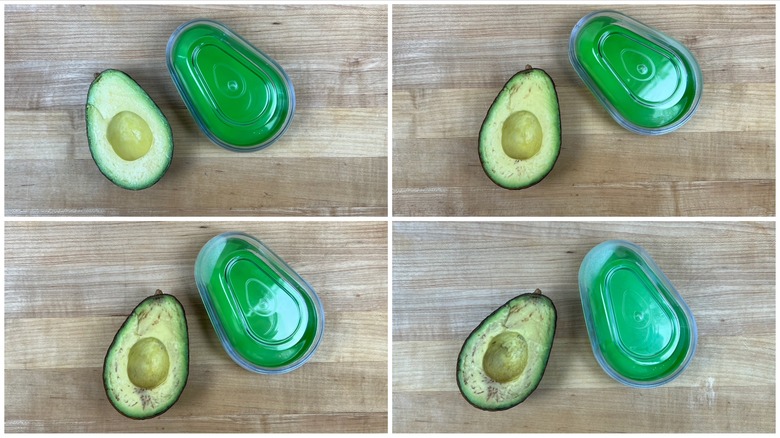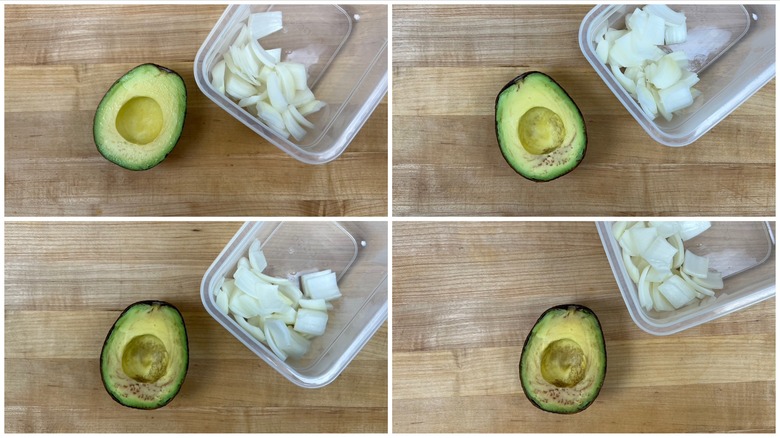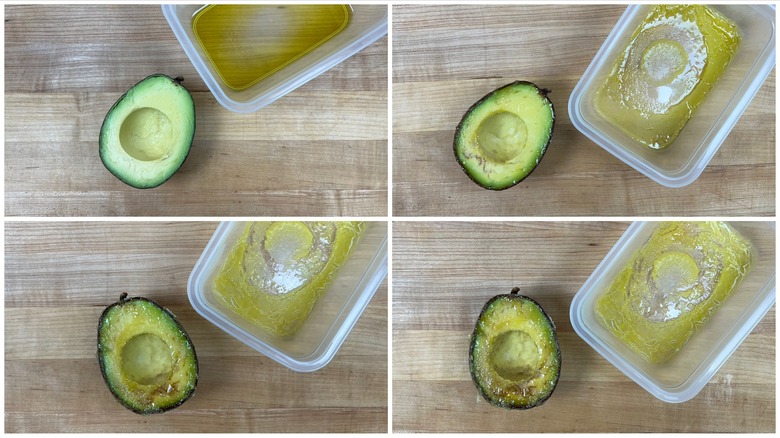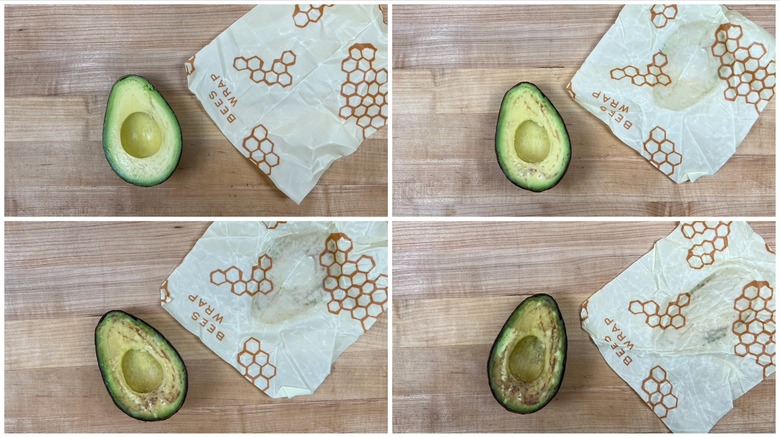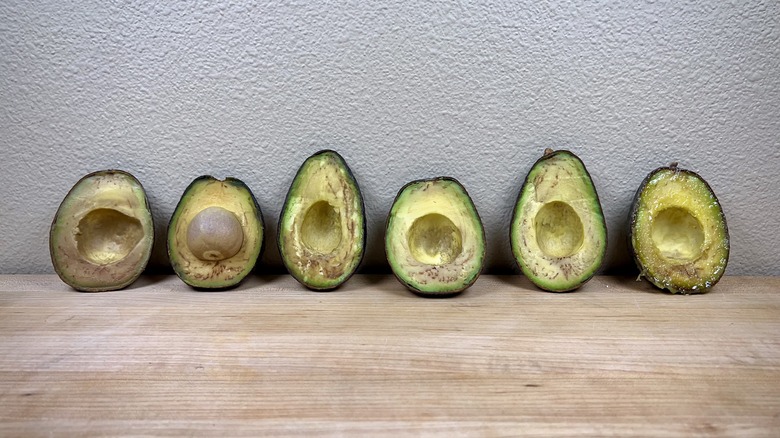The Best Way To Store Cut Avocado, Based On Tasting Table's Test Of 5 Methods
We may receive a commission on purchases made from links.
Avocados are one of those things we love to hate. They're so creamy and wonderful, and they have an uncanny ability to elevate regular dishes into spectacular editions. Sliced avocado adds a rich element to sandwiches or burgers, and there's no denying that mashed avocado with herbs and spices is an ideal addition to our favorite Tex-Mex dishes. But despite how fantastic they taste, they are a huge pain. You have to buy them at just the right moment so they're ripe enough to eat but not so overripe that they're mushy, and they don't exactly store well, either. While it's usually safe to eat a brown avocado, it's not really that appetizing.
The culprit here is oxygen, which creates a chemical reaction with the exposed avocado flesh and turns it brown (something called oxidation). There are many methods for reducing that reaction to preserve the extra half for the next day, so we put a few to the test. We sliced into three avocados and started the clock. We left the pit in one half as our control subject and removed the pits from the other three, storing them cut-side-down in various storage containers. After four days in the refrigerator, we examined the fruits of our labor to see which method fared best.
Don't store your avocados in water
You may notice that we didn't include the viral avocado storage hack that's been making the rounds on social media. This method involves submerging uncut avocados in water before storing them in the refrigerator. After several weeks in the sealed container, the avocados emerge looking just as fresh as the day they went in. Sounds too good to be true, right?
Unfortunately, the United States Food and Drug Administration doesn't recommend using this method as it leads to food safety concerns. While the trick does keep the avocado from overripening, it also creates the conditions for bacteria growth. Any pathogens that were on the avocado skin could multiply in the water and lead to foodborne illnesses like salmonella or listeria. Instead, it's much better to leave uncut avocados on the shelf just as they are. The cool temperatures of the refrigerator are all you need to keep those avocados from getting soft and mushy.
Method 1: Avocado pod gadget
We absolutely love reusable produce savers, providing us with options that don't involve single-use plastic. They range from around $5 to $15 and are available at most grocery stores. Depending on their shape and size, many of these gadgets can be used for multiple produce items, like avocados, cucumbers, onions, and tomatoes. Based on the reviews, we chose to test the Prepworks by Progressive Avocado Keeper ($14.85 from Amazon).
According to an answer from the manufacturer on the product's Amazon page, the container works because the airtight seal prevents oxygen from reaching the cut avocado, keeping it fresh. The pod features a bright green plastic tray and a clear plastic lid that snaps easily into place. We placed the avocado cut-side-down on the tray and affixed the top before storing it in the fridge.
After a day in the refrigerator, this avocado was still looking pretty good. It had deteriorated slightly by day three and had significant brown spots by day four, but the avocado was still edible. It maintained a good texture, and it was still bright green a quarter-inch below the surface.
Method 2: Cut onion
We hadn't heard of this unexpected way you should store cut avocado, but we were pretty impressed with the results. To give this method a go, you'll need half an onion (we used a yellow onion) and an airtight container. Remove the pit, place the avocado cut-side down in the container, and add the chopped allium. The idea here is that onions emit sulfur (the same compounds that make you cry when chopping onions). That prevents the air from reacting with the avocado flesh, keeping it greener for longer.
This method didn't look quite as good as the avocado pod on day two, but it was still decent enough to eat. The onion aroma had penetrated the avocado, but only slightly. Things continued to deteriorate from there, with the avocado browning a little on day three but looking similar on day four. By the third day, the avocado was still edible with a good texture, but the downside of this method is that your avocado will definitely smell (and taste) like onions.
Method 3: Olive oil
Olive oil can help keep your avocados from going brown by creating a barrier that protects the flesh against oxygen. We poured about a tablespoon of olive oil into an airtight container and pressed the avocado's cut side into the oil. To make sure the olive oil would work on the indented portion that previously held the pit, we also rubbed a little oil directly onto the flesh. After a few hours in the refrigerator, the olive oil had solidified, and we hoped that it was enough to keep that pesky air away from our creamy treat.
A single day in the refrigerator revealed that this method had real potential. The avocado had a few brown streaks on the bottom edge on day two, but the rest of the flesh was still bright green. It smelled lightly of olives in a pleasant way, and the taste wasn't affected. The solidified olive oil did come off of the container and clung tightly to the avocado, so you'd want to remove that with a towel before eating the avocado. From there, the avocado did brown slightly on days three and four, but not nearly as much as the other test methods. Of all the test methods, this avocado retained its natural texture and was the least mushy.
Method 4: Lemon juice
Lemon or lime juice was the most common method we heard about when we asked our friends and coworkers about the best ways to keep avocados fresh. Fresh citrus contains two compounds that are supposed to prevent browning: Citric acid works as a preservative, and ascorbic acid protects the avocado flesh from oxygen. We rubbed freshly-squeezed lemon juice over the top of our avocado, making sure to cover all the avocado's crevices. Then, we stored the avocado cut-side down in an airtight container so it was subject to the same conditions as the other testing methods.
It was immediately apparent that this method did not work as well as everyone thought. While the lemon juice did affect the avocado's flavor, it was in a pleasant and familiar way (we've all had avocado mashed with lime juice in guacamole, after all). The issue here was the color and texture. On day two, the avocado appeared browned almost all over and was significantly mushier. By day three, it looked extremely unappetizing, and it was so dark we worried it might be rotten by day four. Of all the methods, this is one that we wouldn't repeat again.
Method 5: Beeswax wrap
For our final test, we used an eco-friendly alternative to plastic wrap. Reusable beeswax wraps are made by coating cotton with beeswax, organic jojoba oil, and tree resin. They are a little expensive, but these wraps can be washed and reused for up to a year with proper care. It's important to ensure no excess moisture remains on the cloth before using beeswax wrap, though, as this all-natural product can produce mold.
We used a small, 7-by-8-inch wrapper to cover the avocado. After warming the wrapper with our hands, we pressed the cut side onto the wrap and gently folded the pieces to create an airtight seal. We were impressed when we saw that the avocado had very little browning on day two. It wasn't quite as nice as the pod or the olive oil, but it was certainly good enough to eat. That said, it was difficult to re-wrap the avocado after it came out of the refrigerator. The beeswax requires a little heat to seal properly, which you can usually accomplish by massaging it with your hands. Since the wrap was fresh out of the cold refrigerator, it was challenging to get it warm enough to seal. We could see how that affected the avocado on days three and four when the product continued to get browner and browner. This avocado was perhaps slightly mushier than the other testing methods (although nowhere near as mushy as the lemon).
Verdict: The avocado storage method that worked best
After four days, we definitely had a clear winner. None of the methods completely prevented the browning, but the olive oil was the most successful. The oil barrier best prevented oxidation, keeping the avocado greener than the other methods. Of course, you'll want to wipe the olive oil off before you eat the avocado, as it got caked on pretty thick after solidifying. It did add a slight olive flavor to the avocado (but not one that we minded). The next two successful candidates were the avocado pod and the onions, followed by the beeswax. The lemon was our least favorite method. It actually looked worse than the avocado half we threw into the fridge with no storage at all.
If you're only storing the avocado for a single day, every method — except the lemon — was successful. The uncovered avocado hardened a little more each day, but each storage method preserved the avocado's creamy texture. We liked the beeswax, but you'll definitely want to be sure to warm the wrap enough with your hands to make an airtight seal. And the onion method totally worked, but you have to enjoy that onion flavor.
All in all, if there was a single method we'd use as our go-to option, it would be the pod. It looked the best after a single day in the fridge, and it was also the least time-intensive method. The pod we tested happens to be dishwasher safe, too, and we always appreciate an easy clean-up.
